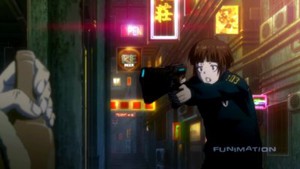Carlo Santos
Having grown up on too many cartoons and comics, Carlo has channeled his obsession into 8 years of work at Anime News Network. He is best known for the Right Turn Only!! column, which look at new manga releases in North America every other week. Based on his wide-ranging (and sometimes unusual) tastes, his favorite anime series of the last few seasons include Chihayafuru, Another, Black Rock Shooter, Kids on the Slope, Polar Bear Café, Humanity Has Declined, and Joshiraku.

Rating: 1 (of 5)
Review:
At first, Aikatsu! just seems like one of those bland reach-for-your-dreams children's shows. The story centers on average schoolgirl Ichigo, who discovers one day that her younger brother has developed a crush on a major pop idol. As a result, Ichigo and her classmate treat him to the time of his life by going out to a concert. Predictably, Ichigo becomes interested in the idol world, and suddenly she wants to sing and dance and enchant audiences with her youthful charm.
The story starts to get really weird when Aoi tells Ichigo they should both audition for a prestigious academy where idols are trained. (In real life this would be a basement dance studio where you sweat for 6 hours a day after regular school.) At this academy, the most important part of becoming an idol is ... co-ordinating one's outfit with collectible fashion cards. And having that outfit electro-magically beamed onto you to perform in.
That's when the ridiculous truth comes out: this show is a commercial for a card-based arcade game aimed at young girls.
It's bad enough that Episode 1 is entirely predictable: idols are glamorous, you can become one if you just believe in yourself, blah blah blah. But even worse is how thegame's concept is grafted onto the premise, turning it from just plain mediocre to mind-bendingly stupid. At this point it'd be more believable that girls train to be idols in order to fight an oppressive intergalactic government.
As expected, the animation quality is barely enough to get by, and the character designs look oddly outdated. (Didn't neon-colored hair go out with the 90's?) The CGI abuse during stage scenes makes actual idol performances unbearable—there's nothing cute or charming about stiff 3D models twirling their limbs in what appears to be "dancing." And the songs? Well, just like everything else, they're a watered-down imitation of what you'll find in the real idol business. Obviously, the only way to enjoy this show is as a tie-in to another entertainment product, because taken on its own, Aikatsu! flops completely.

Rating: 3 (of 5)
Review:
Robotics;Notes introduces itself quietly, with a casual school-life atmosphere and a pair of likable leads. In Episode 1 we meet Kaito, a slacker-gamer type involved in his school's Robot Research Club, and his friend Akiho, a bubbly, geeky girl who plans to complete the club's dream of building a full-size mecha. As the club's only members, though, it's hard earning any respect, much less the funding they need for robot components. The club advisor offers them a deal, though: if Kaito and Akiho can win a local robot-building contest, they'll receive the support they need to finish the mecha and take it to a tech show in Tokyo. But the contest takes place in just two weeks ... and an otherworldly stranger is watching their every move. (See, there has to be a mystery element in there somewhere.)
Scientifically-inclined fans can easily see the appeal of Robotics;Notes: you want these kids succeed, to build a real working mecha and wow the world with epic robot action. Akiho's high-spirited attitude is a big selling point, as is her addiction to a mecha anime called GUNVARREL (a clever parody that blends all the classics together). Kaito's relaxed, slightly sarcastic personality is the perfect complement, and the interplay between the two keeps the first episode going—because there isn't much plot to speak of yet. Even the robot's specs are barely mentioned, but based on the show's attention to technological detail (check out Kaito's tablet), they're just waiting for the right time to roll it out.
As expected, the laid-back storyline means there aren't too many opportunities for dazzling animation. Aside from Kaito and Akiho launching their mecha in the opening scene (presumably a vision of the future), the main visual appeal comes from the idyllic backgrounds and warm sunset light as the two kids hang out at the club's hangar. Character designs look pretty ordinary, but Akiho's spirited gestures—so full of life for a 2D creation—show what the animation staff are capable of. For now, however, we'll have to be patient until the real robot action kicks in.
Robotics;Notes is available streaming on Funimation.

Rating: 4 (of 5)
Review:
Futuristic crime-solving, lofty sci-fi concepts, and Production I.G in the credits—why, it's like Ghost in the Shell: Stand Alone Complex all over again. PSYCHO-PASS may not be attached to a big-name franchise, but it hits all the right notes in exploring the dark side of high technology. Akane Tsunemori is a new police recruit in a society where citizens are judged by their "Psycho-Pass"—an instant brainwave scan that identifies criminal tendencies. The cops even use fancy guns ("Dominators") that automatically run a Psycho-Pass test on any target, calculating whether to shoot or not. The creepy dystopian elements don't stop there: the police also employ "Enforcers," criminals who fail the Psycho-Pass test but serve as assistant crime-solvers because it takes one to know one. These ideas are explained as Akane and her squad head out on a mission, cleverly weaving the plot and background information together.
The series doesn't compromise on shock value: Akane's first target is a kidnapper and would-be rapist, and the mission takes a dark turn when the criminal uses his own hostage as a potential weapon. That's because victims of violent crimes can suddenly exceed acceptable Psycho-Pass limits, their brains going haywire from the stress. Thus Akane faces a tough moral decision—shoot the victim because she's technically a threat, or let it go because she's innocent? Akane's superior officers will have plenty to say about her choice ...
The real genius of PSYCHO-PASS is how it straddles multiple genres and makes them all work: intense crime drama, neurology-based science fiction, ethical debate, and good old blood-spattering action. The animation isn't as technically dazzling as something like K, but look at the realistic world it creates: the shady characters, the bustling urban environment, the detail that goes into Akane's gadgets. The gunfights are the most visceral scenes, of course (consider yourself warned about graphic content), but even the sight of Akane inching down a dark alley strikes a powerful mood. With a shiny-yet-grimy look, and an edgy, modern soundtrack to match, this is one of those shows that'll still feel futuristic even years from now.
PSYCHO-PASS is available streaming on Funimation.

Rating: 1 (of 5)
Review:
As the name suggests, Girls und Panzer falls in the niche of "cute girls doing military things"—in this case, driving tanks. The problem with Episode 1 is that it's about 140% cute girls, and 20% tanks. A brief opening scene shows tanks rumbling across the landscape while stirring military music plays in the background, but then it reverts to a generic slice-of-life scenario. Protagonist Miho Nishizumi takes a leisurely stroll to her all-girls high school, where she nervously makes new friends and is pressured by the student council to take the "Tankery" special-skills elective.
As it turns out, Miho actually comes from a family involved in the tank industry, but due to a past childhood trauma, she wants nothing to do with it. Yet that personal background is exactly why the student council wants her taking the elective, and besides, girls who can pilot tanks are highly regarded in society (according to a propaganda video). Eventually, Miho's friends convince her to give it a try ... but by the time the first Tankery class gets started, the episode is practically over.
Even if one can accept this strange concept (there's actually a good reason why they teach Tankery in high school, as revealed in an end-of-episode twist), the plotlessness of Episode 1 makes it hard to get into the series. Miho's high school life is presented as one dull conversation after another, blindly following the first-day-of-school template. It's even boring to look at: every dialogue scene is shown straight-on or from the side.
Of course, the early tank scenes should have given it away—this is animation on the strictest of budgets, where almost everything is computer-modeled and then cel-shaded to simulate "proper" anime. That explains the sterile scenery, the almost-robotic motion of the main characters (easy to hide when they're just sitting at their desks), and the tanks that stick out conspicuously from the rest of the visuals. Between the hackjob animation and poorly scripted story, this show bombs before it can even get rolling.
Girls und Panzer is available streaming on Crunchyroll.

Magi
Rating: 3 (of 5)
Review:
Taking its cue from Middle Eastern lore, Magi reimagines a couple of famous storybook characters the way only anime can. Alibaba is now a blond-haired merchant's apprentice, while Aladdin is a bratty kid who pops into Alibaba's life after stowing away on a cargo wagon. As expected, they live in a bustling desert town—certainly a different setting from the usual medieval or Japanese villages where adventures like this begin.
The entire first episode follows a textbook formula as it introduces viewers to a world of exploration, battle, and magic. Early on, Alibaba tells Aladdin about dungeons—mysterious towers full of treasure and danger—and his thrilling life goal of conquering dungeons around the world. However, Alibaba's current existence is full of injustice and servitude, and Aladdin gets into scraps of mischief trying to right these wrongs. Alibaba's boss, fed up with such shenanigans, clamps down and orders Alibaba to help deliver a shipment of wine. But after being told to protect the goods instead of saving imperiled slaves, Alibaba's sense of heroism finally kicks in, and Aladdin comes to his aid with a powerful Djinn he's had stored up the whole time. Not a bad way to quit your job and embark on a quest for fortune.
Obviously, this concept is nothing new—just your average boy hero going on a fantastical journey—but the setting alone is enough to sell the series. It's not every day that the Middle East pops up in anime, so there's a whole world of folklore and culture waiting to be explored. Distinctive costumes and backgrounds, plus a richly orchestrated score, give the series enough flavor to set it apart from every other vaguely European fantasy universe. The animation could stand to be better, though—aside from the smoothly executed action and magic scenes, there's a lot of choppy motion and uninspired directing that makes this look like just another shonen adventure. In some ways, it is. But it does just enough to be different.
Magi is available streaming on Crunchyroll.

Shin Sekai Yori (From the New World) Episode 2
Rating: 3 (of 5)
Review:
After an intriguing first episode, the novelty of From the New World is already in danger of wearing off. Episode 2 begins with a striking moment from Japan's post-apocalyptic "history"—the coronation of a new Emperor, five hundred years from now—but after that, it reverts to the chronicles of daily life and kids being kids in the thousand-years-ahead era. An entire half of the episode is spent on the Unified Class playing a future sport known as Carryball, where teams of psychic students must use their Power (yes, with a capital P) to maneuver a heavy stone ball into a goal. The tension of the game, plus some fancy manipulation of the rules, help to make it interesting ... for fans of the sports genre. But it doesn't add much to the story, aside from a fateful incident surrounding a student who cheats.
The second half sees the students interacting more with the world around them, as they prepare for a camping trip and run into some Monster Rats—a strange, mutated humanoid species—on the riverbank. Again, these events are more about setting the stage than diving into serious drama. While it's fun to soak in the details of this post-future world, the series' Slow Start is a test of one's patience. Trying to get familiar with the main characters is a challenge too—they always move in a pack, which results in sporadic small talk instead of deep conversation, and it's still hard to tell the kids apart when everyone's got the same eyes and face shapes.
For now, the subtly beautiful animation is what will keep fans hooked on the series—the warm sunset light, the picturesque backgrounds, and the surrealness of that entire first scene with the Emperor. (We'll forgive the clunky CGI in the Carryball segment, since psychic sports are probably not the main focus.) From the New World gives viewers plenty of things to quietly admire—but if it stays quiet too long, this carefully crafted sci-fi world may end up going to waste.
From the New World is available streaming on Crunchyroll.

Rating: 1.5 (of 5)
Review:
Sakurasō no Pet na Kanojo tries to say something amusing about the chaos of school life, but with its lowbrow humor and poorly organized storyline, the only part it succeeds at is chaos. Say hello to student Sorata Kanda, who lives in the infamous Sakurasou dorms—a dumping ground for "problem kids." Not that he's a troublemaker—he just wanted to keep a stray cat, and the regular dorms wouldn't let him. Now Sorata finds himself surrounded by freaks, including a hyperactive animation genius, a wanton playboy, and even a shameless teacher scoping out rich daddies on campus. As the school year begins, a new student named Mashiro moves in. Her enigmatic appearance catches Sorata's attention at first, but on the first day, he discovers what a slob she is, turning their prospective friendship into a comical mess.
In better hands, this might be the setup for a goofy ensemble comedy, but not here. The first episode shows little creativity in introducing the main characters—"Here's a list of names and traits, have fun"—and it doesn't get much better. The humor is simple-minded and often repeats itself; how often do we have to hear about the teacher trying to pick up dads during the school entrance ceremony? The frequent sprinklings of fanservice also do nothing more than prolong the running time, especially in the closing scenes where a big deal is made about Mashiro being not being properly dressed. (Yep, you just wanted to show her naked...)
Surprisingly, this episode has moments of beauty—most notably when the pacing slows down, the music turns quieter, and everything glows in a soft, warm light as Sorata reflects on his life. Also, the animation overall stays pretty sharp, with a wide range of colors that one might not expect from a low-level gag series. But the effort stops there, and the rest of it is pretty weak, with stereotypical character designs, generic school environments, and CGI sakura petals thrown into every scene. Don't be fooled by the series' good looks: inside lies another failed attempt at campus comedy.

Rating: 2 (of 5)
Review:
Oh goodness, not another one. Does this sound familiar at all? Ixion Saga DT tells the tale of Kon, a young man who loves online role-playing games, but gets into a world of trouble when his fantasy adventures get a bit too real. A seductive female warrior asks Kon for a favor in the game, and when he accepts, he is transported into an actual medieval landscape, where a villainous, sword-wielding army is out for blood, and a ragtag band of adventurers are trying to protect a princess from these would-be captors.
The series tries to laugh it off with some self-deprecating humor—"What kind of fantasy name is that? You wouldn't even use that in an anime!"—but trying to poke fun at such clichés, while still insisting on being a straight-up adventure, just makes the flaws more obvious. Not that the humor is all that great anyway: Kon makes a couple of about his virg—oh, they can't say that in a family show, and when a major villain shows up to challenge him, the winning attack turns out to be a lowbrow slapstick gag. Looking at more serious matters, the world-building is devoid of any imagination; it's just warriors and kings and castles and weapons all labeled with fancy names. (Yes, the series tries to make fun of fancy weapon names as well, to mild effect.)
If it's any consolation, the animation looks a little more polished than the average bargain-bin fantasy anime—bright colors and subtle details here and there, plus some unexpected camera angles to make the battles more lively. But that's where the creativity stops. Each of the fight scenes ends up being a sword-swinging melee, while the character outfits and background art show little interest in breaking the fantasy mold. And we won't even speak of the background music, which sounds like it was repurposed from the MIDI files of old 90's RPGs. Is this trying to be a "game comes to life" show, or just poke fun at the concept? Either way, it lacks the verve to succeed.
Ixion Saga DT is available streaming on Crunchyroll.

Rating: 2 (of 5)
Review:
Pity poor Sakura Sakurakouji. She's a model student, admired and loved by all, but she's become a paranoid wreck ever since she witnessed something she was never meant to see. Code:Breaker begins with a shot of people being burned alive in blue flame, while a scowling boy looks on. Sakura watches this in horror while riding a bus on the way home, but when she tries to investigate, she finds no physical evidence. To make matters even more suspicious, that scowling boy—who goes by the name of Rei Ogami—has transferred into Sakura's class! Is he a murderous freak, or was it all imagined?
This sounds like it could be brilliant and suspenseful, but instead it combines the worst of various anime clichés. Sakura has basically walked right into the much-overdone "teenage kid uncovers a world of secret powers" premise, while the other main character shows up by means of the "mysterious transfer student" device. Sakura and Rei's school life is the most generic ever, with all their classmates thinking she's about to confess to him when she actually wants to ask about the blue flame incident. The final act of Episode 1 brings in the obligatory badass action sequence, where criminal goons appear on the scene (hey, those burned-up people must've had some friends) and Rei demonstrates his flame-shooting powers in order to save Sakura. If it's any consolation, the series does spare a little humor—it's not totally self-conscious and serious, and neither is it stupid and pandering, but the whole thing is just painfully average.
The animation standards could also be described as painfully average. There's enough budget thrown into the production to make the character designs crisp and consistent, but the actual directing shows little creative spark—the characters step right into predictable action poses and fighting moves when it's time for battle. The school scenes are even more dull to look at, with one classroom conversation after another. The way this episode is paced, it feels as if everyone is plodding along, just going through the motions, while trapped forever in an action-adventure cliché.

K
Rating: 3.5 (of 5)
Review:
If we were grading things on style points alone, K would probably get some ridiculous score like a 12 out of 5. That's how amazing this show looks, with its sumptuous sci-fi cityscapes, luminescent color scheme, and filters and effects to give it that futuristic glow. And that's not even talking about the action scenes, where dramatic angles and super-slick animation will make many viewers sit back and gape in wonder. Oh, and did I mention the contemporary, fashion-forward character designs? (Except for the guys dressed up as Fullmetal Alchemist.)
Unfortunately, K gets so caught up in this artistic indulgence—and the chill-out hip-hop soundtrack that goes with it—that it forgets to tell much of a story. As far as one can gather, it's about an urban war in a near-future version of Tokyo, where a gang dressed in stylish street clothes is at odds with the aforementioned Fullmetal Alchemist lookalikes in their long coats. Thrown into the center of this war is Shiro, a high school boy living a very relaxed, go-with-the-flow existence. (The episode spends far too many minutes showing just how relaxed he is, rather than advancing the plot.) While on an errand, Shiro is spotted by members of both rival factions, and gets kidnapped by one of the street guys on a skateboard. As expected, this incident leads to a highly concentrated dose of eye candy. As luck would have it, though, one of the guys in the snappy coats steps in and announces his plan to kill Shiro with his sword ... because, according to shocking video evidence, Shiro is responsible for a fatal shooting.
That last bit is really the only substantial plot point in K's first episode, and only takes a small fraction of the runtime; most everything else is "Look how gorgeous this city background is" and "Look how stylish these urban gangster-warriors are." Not that there's anything wrong with looking at pure, mind-blowing art for half an hour—but at some point there needs to be more to it.
K is available streaming on Viz Anime and Hulu.

Rating: 3 (of 5)
Review:
Set your nostalgia meters to the 80's—it's the new remake of JoJo's Bizarre Adventure! Out of the franchise's many storylines and characters, this new series picks the late 19th century as its starting point. Episode 1 begins with Dario Brando, soon-to-be father of Dio Brando, saving the life of aristocrat George Joestar and his infant son Jonathan, thus earning a favor from the rich old man. Fast-forward twelve years, to a now-adolescent Jonathan (nicknamed "Jojo"), whose coddled lifestyle is disrupted when Dio Brando moves into the Joestar household after Dario's death. Despite his working-class background, Dio is ruthlessly ambitious—he sees the Joestar family as an obstacle to be conquered, and does everything to look like the perfect adopted son while making Jojo's life embarrassing and miserable.
The episode does a fine job of planting these seeds of conflict, and brings it all to a head in the latter half when Dio forcibly kisses the girl that Jojo likes. That, of course, is the ultimate blow to young Jojo's pride, and the two boys get into an bloody fistfight that foreshadows the shocking supernatural battles to come. So ends a fairly orthodox origin story—here are the main characters, here's how they meet, and here's why they hate each other so much. Although things get off to a dramatic start, it'll obviously take more time to develop daring twists and subplots.
While the distinctive retro style of the Jojo manga is clear to see in the character designs, along with neon-colored filters that are thrown over some of the more dramatic scenes, that's about as far as the animation goes in being creative. Otherwise, it's pretty average: motion is occasionally choppy, and static fighting poses show up more than one would like to admit. The backgrounds, while accurate for the period, lack any real sense of life. It's like everyone just turned in their artwork and went home, hoping the legendary characters, epic storyline, and dramatic background music would carry this one. But is it still truly Jojo if the visual fabulousness gets watered down?

Rating: 4.5 (of 5)
Review:
Do you like action? Explosive, blood-soaked, butt-kicking action? Then BTOOOM! is this season's must-view series. Like several others, it jumps on the "anime about a video game that turns into real life" bandwagon, but instead of getting hung up on the game's details, it's all about the thrills and dangers of real life-or-death gaming. As one can guess, BTOOOM! is also the name of the game, which takes the team-based shooter concept and gives everyone bombs instead of guns. Twenty-two-year-old Ryouta Sakamoto is one of the world's best players at BTOOOM!, and when he starts up an online match one day, he suddenly blacks out and re-awakens in a hostile jungle. Sakamoto escapes the jungle and ends up on a beach, but then realizes he's carrying a satchel full of real bombs—and there's another bomb-wielding maniac nearby trying to kill him! Using his wits, Sakamoto survives the threat ... but a stay-at-home online gamer is obviously in no emotional state to handle this kind of excitement.
The series wastes no time in going from good to great—the sense of urgency and dramatic action sequences as Sakamoto fights for his life are all perfectly executed. What's more, this episode also works in some meaningful back-story: we see snippets of Sakamoto's lazy lifestyle and troubled family relationships, all of which serve as a dramatic contrast to the life-or-death scenario he's stepped into. There are also hints of a sinister sci-fi conspiracy that's responsible for this strange phenomenon.
Stunning visuals are also part of the reason this series excels: every scene features detailed background art and character animation, no matter whether it's Sakamoto racing through the jungle or mousing around on his home computer. The entire first fight sequence happens at night, yet the sharp linework and color palette make everything easily visible. On top of that, the heart-pounding, dissonant music score amplifies every emotion running through Sakamoto's head. For a certain fan demographic, this is the reason they fell in love with anime: intense, otherworldly action that can't be found anywhere else. So prepare to fall in love all over again.
BTOOOM! is available streaming on Crunchyroll.

Rating: 3.5 (of 5)
Review:
Blast of Tempest centers on high school boy Yoshino, who (like every other high school kid) is about to discover a secret world of magic and warfare. But first we meet Yoshino's closest friends: notorious best buddy Mahiro, who's suddenly stopped showing up at school, and Mahiro's sister Aika, who often hung out with them until her unexplained death. One day, Mahiro re-emerges armed with magical powers, which he uses to save Yoshino from the clutches of a decidedly suspicious woman. Mahiro then explains what he's been up to: after receiving a message in a bottle, he made a deal with a sorceress exiled on a desert island, agreeing to fight on her behalf in exchange for magical assistance in finding Aika's killer. An epidemic of humans turning into metal is proof enough that Mahiro and Yoshino have been pulled into this mystical war—along with the appearance of a giant, menacing spherical thing.
This show almost crashes and burns before it can ever take off—the first half of Episode 1 tries too hard to be fancy, with time-skipping cuts and scene changes that result in confusion more than curiosity. But the pivotal action scene where Mahiro shows off his newfound magic helps to pull it all together, and eventually the story makes enough sense to form the foundation of a solid fantasy-action series. Some plot elements are still pretty arbitrary—where did these bad guys come from, what do they want, and how do people just "get" these magical powers?—but such questions will probably be answered over the course of future episodes.
Although the character designs aren't terribly imaginative, that's really the only artistic weakness. Overall, the visuals are as polished as they come. Mahiro's duel is an eye-catching, smoothly choreographed set piece, and even scenes of everyday school life are carefully detailed and shaded. The grand, full-orchestra soundtrack during battle scenes and critical conversations is further proof that the series wants to be taken seriously—and it's just about good enough to have earned that right.
Blast of Tempest is available streaming on Crunchyroll.

Rating: 2.5 (of 5)
Review:
English speakers may know this one in manga form as Kamisama Kiss, but either way, Kamisama Hajimemashita is a sweet serving of supernatural fluff. Unfortunately, that's all that's it's got going for it—behind the folklore-driven setting and lively pacing is just another typical girl-meets-boy story.
The girl in this case is 17-year-old Nanami, a student who's hit the absolute rock bottom: her deadbeat dad has run off, and she's been evicted from her apartment. However, after she saves a skittish young man from being attacked by a dog (the first of many wild scenarios in this episode), Nanami gets a lifeline—the young man gives her directions to his house, where she can stay in the meantime. There's a catch, though: the young man is actually a local god named Mikage, the "house" is an abandoned temple, and living in it is a fox-spirit/prophet named Tomoe, who doesn't take kindly to the new girl taking Mikage's spot.
What happens next is a whole lot of fish-out-of-water humor, relying more on maniacal energy than originality: Nanami runs around trying to maintain the temple grounds, hear the petitions of passing worshippers, and deal with two little mascot spirits who give instructions in annoying, super-high voices. She's also trying to get Tomoe back on her side after his grumpy departure from the temple. This leads to a wild forest adventure where Nanami learns the only way to guarantee Tomoe's loyalty is to kiss him.
(Like anyone didn't see that coming.)
Even as the story works out the deeper details of its premise, it leans more toward silly than serious, and the characters fail to show much potential outside of their preset personality types. Meanwhile, the visuals seem cute enough upon first glance, with appealing character designs and comical shifts in art style, but the lack of effort in the animation—lots of static images or repetitive motion—lets the whole production down. The bouncy, lighthearted music gives off the same impression: likeable at first, but not much else to it after the charm wears off. Kind of like this whole story, really.

Hayate no Gotoku! Can't Take My Eyes Off You
Rating: 3 (of 5)
Review:
It's business as usual in the newest incarnation of Hayate the Combat Butler: goofy characters, slapstick gags, and the occasional dose of fast-paced action. Can't Take My Eyes Off You features an original scenario penned Hayate manga-ka Kenjirō Hata, which should please longtime fans, while newcomers can also jump in thanks to the brand-new storyline (the only requirement is some basic knowledge of the characters). Hayate Ayasaki is the star of the show, a hard-working young butler trying to keep up with the demands of fickle heiress Nagi Sanzenin. Much of the series' broad humor comes from poking fun at Nagi's self-centeredness: she gets up at noon, watches anime and plays games all day, and complains whenever Hayate (or resident maid Maria) suggests she might want to do something with her life, like going to school.
The episode drifts along with this casual, everyday humor until the Sanzenin household gets an anonymous phone call and Nagi learns that her long-deceased father left some personal effects behind in Nevada. What a coincidence: Nagi was just thinking how fun it'd be to visit Area 51 and go alien-hunting on a whim. Things get more intense when Nagi, in the middle of an argument with Hayate about when to travel, gets kidnapped by money-hungry goons. The last few minutes of the episode really step it up as Hayate goes on a superhuman chase to save Nagi—and a mysterious new girl who'd been following Hayate around declares her role in this burgeoning plot.
The good news, then, is that this is more than just a cheap cash-in. Simple-minded comedy aside, the plot does have some substance to it, with the promise of action and adventure down the road. The animation also shows more effort than one usually expects from the franchise: Nagi's mansion looks exceptionally well-furnished, and the camerawork tries to make even basic dialogue scenes interesting. Hayate's chase scene is the big visual stunner, of course—but all the little things add up too, and the sum of these parts is an enjoyable new Hayate series.
Hayate no Gotoku! Can't Take My Eyes Off You is available streaming on Crunchyroll.

From the New World
Rating: 4 (of 5)
Review:
From the New World may not have much to say in its first episode, but what it does say is plenty intriguing. The story begins one thousand years in the future, with humankind having reverted to a pre-industrial lifestyle. The customs and traditions of this new world are, to say the least, a little different from the 21st century. Main character Saki Watanabe has just manifested her psychic abilities, which means she gets to graduate from Harmony Elementary and start studying at the Unified Class with the rest of her peers. This also means partaking in an eerie religious ritual that marks Saki's coming-of-age. As Saki gets into the swing of her new school life, we learn that she is considered a late bloomer, that some students have mysteriously disappeared in the transition from elementary to higher grades, and that her parents are worried because of Saki's strange visions about an ominous "Trickster Cat."
Right now it just seems like a collection of plot fragments—some high-concept science fiction here, a quiet slice of school life there, and subtle hints of mystery and horror. But what the first episode lacks in story structure, it makes up for in atmosphere: the sheer strangeness of Saki's coming-of-age ceremony, the uneasy conversations among her peers and her parents, and a cliffhanger ending that succeeds by its simplicity. Rather than trying to be flashy or melodramatic, the series pulls in viewers with gentle but sinister fingers.
Audio and visuals are also key components in setting the atmosphere: every scene is a study in muted colors, even the gold-and-brown sunsets. The background art also brings out the low-tech feel of this society, with pastoral landscapes and wooden small-town houses. Oddly enough, however, the character designs look too simple compared to the rich detail elsewhere, and the children's faces might take some getting used to. Meanwhile, a sparse but striking soundtrack adds to the ominousness: even the sweet singing melody of Dvorak's most famous symphony comes tinged with sadness. The future looks calm and relaxed, but strange things are definitely afoot.
From the New World is available streaming on Crunchyroll.

Rating: 3 (of 5)
Review:
Here's a familiar one: ordinary high school girl meets difficult yet endearing high school boy, and wackiness ensues as they try to get along with each other. Yes, My Little Monster isn't attempting anything ambitious, but what it does, it does well.
In the lead role is student Shizuku Mizutani, a smart girl who makes a little extra pocket money running errands for her teacher. Her latest assignment leads down an unexpected path: she has to persuade truant student Haru Yoshida to return to school, a challenging task considering that Yoshida got suspended for fighting. When Shizuku finally tracks him down, he's hanging out with some shady guys at a game center, and only by treating Yoshida as a genuine friend is Shizuku able to soften his harsh exterior.
However, Yoshida's softness runs unexpectedly deep. After the two become friends, Yoshida's insecurities about being disliked lead to amusingly clingy behavior: he follows Shizuku around, wanting to do stuff with her, but can't stop himself from beating up others at every imagined slight. He turns into even more of a hilarious wreck when he reads a romance novel for advice on how to treat girls.
Much of the humor comes from Yoshida's overreactions to ordinary situations—just the right level of quirky to make his "bad guy" persona likeable. Thankfully, Shizuku has enough backbone to set him straight, and the resulting chemistry between the two is well-balanced. The opening episode also finds enough room to show a little heart, like when Yoshida tries to confess his feelings for Shizuku (despite having the emotional awareness of a rock), along with vulnerable moments where he admits he just wants a good, honest friend.
The vivid colors and fairly detailed character designs should also win over fans, even if the animation stays simple and only steps it up for high-energy gag scenes. A lack of visual creativity in other areas (generic school, generic students) is compensated by the above-average production values, and the lighthearted music serves as a reminder that this is a series designed to be, above all else, fun.
My Little Monster is available streaming on Crunchyroll.
discuss this in the forum (815 posts) |
this article has been modified since it was originally posted; see change history
back to The Fall 2012 Anime Preview Guide
Season Preview Guide homepage / archives